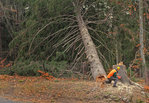

At the Key Pen Parks commissioner meeting held via Zoom April 11, forest managers from the Department of Natural Resources presented its plan to harvest 110 acres of timber from the Key Central Forest. The 480-acre forest is located between the Key Peninsula Highway on the east and Wright-Bliss Road to the west and has been under long-term lease to Key Pen Parks since 2011.
The complete harvest plan includes over 300 acres of forested state trust land from five units that comprise DNR’s School Timber Sale. Approximately 200 acres of the harvest will come from three units located in Belfair.
“One of the things Key Pen Parks can do better is to share that Key Central Forest, along with 360 Trails, are working forests,” said Executive Director Tracey Perkosky. “Key Pen Parks manages the land for recreational purposes, but DNR is the land owner.”
Forested state trust lands are held in perpetuity to provide revenue for specific beneficiaries, such as schools, counties and critical local services.
Public outreach is underway. DNR mailed fact sheets to 55 adjacent neighbors with maps of the harvest areas, general timelines, management practices and the fiducial responsibilities it has protecting and managing over 2 million acres of forested state trust lands.
The appraisal, permitting and the State Environmental Project Assessment process is scheduled to occur from October to November 2022.
“Every individual in Washington state has the opportunity to comment on the SEPA and my contact information is available to hear opposition or any concerns,” said Belfair Unit Manager Allyn Cole, who leads the project.
In December 2022, the proposal will go to the board of DNR for approval before the timber sale is put up for auction in January 2023. Key Pen Parks will see an impact to its lease between February 2023 and October of 2024, when harvest operations are scheduled to take place. After that comes managing vegetation in 2025 and tree replanting in 2026.
Cole said portions of Key Central Forest were harvested and replanted in 1984, 1993, 2001, 2008 and 2017. He said this will be the last entry into this area until the earliest planting in 1984 matures.
“It’ll be quite a long time before we’re back in here again for actual timber removal,” he said. “Silviculture activities will exist — plantings, surveys, pre-commercial thinning operations — and those are still occurring within the other units across the landscape there.”
Commissioner Shawn Jensen said, “Some people hear the words ‘tree harvest’ and they think ‘clear cutting’ and I don’t know what particular type of harvest you’re going to be doing, or whether you’re going to leave some trees up so the trail experience doesn’t lose its character altogether.”
Cole said he used to work in the Capitol Forest, which has a heavy recreation community. He invited user groups to come out and look at a trail to identify areas that have “many cool jumps, bends or something neat they like … or this picnic bench for shade. I can leave trees around there to preserve those areas and would appreciate that communication.”
Commissioner Ed Robison asked, “During the time they are actually performing the timber harvest, will we have to close the whole area to the public?”
Nathan McReynolds, DNR South Sound District Manager said he and Perkosky have discussed the subject and are thinking of proposing that the trailhead in the Northwest Loop should be closed when Unit 5 is harvested. Once that is completed, they would close the Northeast Loop when Unit 6 is harvested.
Commissioner Linda Parry asked if they intended to reopen the Northwest Loop after harvest “even though you haven’t done any of the cleanup or replanting?”
“The cleanout of the trail is a contractual obligation,” Cole said. A clause in the contract requires that as soon as the equipment is within 200 feet of any location on the trail, that has to be rebuilt within two weeks. In addition, “We have our own DNR recreation clause where there is no slash and a few other items,” he said. “And we’ll work with Tracey (Perkosky) to get the trails back into as close to the original condition.”
Commissioner Parry said, “As far as the trust beneficiary goes, yes, it benefits schools but this park benefits our local community in so many ways. I just want to make sure the public has the opportunity to know what’s coming.”
South Sound District Manager Nathan McReynolds said that fish streams like Vaughn Creek will have buffers the width and height that a tree will grow in 100 years, plus a half-tree length. On top of that they plan to leave eight trees per acre.
“We also protect wetlands,” McReynolds said. “If they’re less than an acre they’ll get a 100-foot buffer. If more than an acre then they’ll get that creek-side buffer, which is a tree-length and a half. There’s a lot of protections in place.”
Commissioner and Board Chair Mark Michel said, “I think it’s incumbent on us as commissioners to present to the public that this is a working forest still and that we have the benefit of using it for very little cost. The cost we have to bear is the logging.”
“In the meantime, enjoy the trails, animals, trees and all that Mother Nature has to offer at Key Central Forest,” Perkosky said.
UNDERWRITTEN BY THE FUND FOR NONPROFIT NEWS (NEWSMATCH) AT THE MIAMI FOUNDATION, THE ANGEL GUILD, ADVERTISERS, DONORS AND PEOPLE WHO SUPPORT INDEPENDENT, NONPROFIT LOCAL NEWS